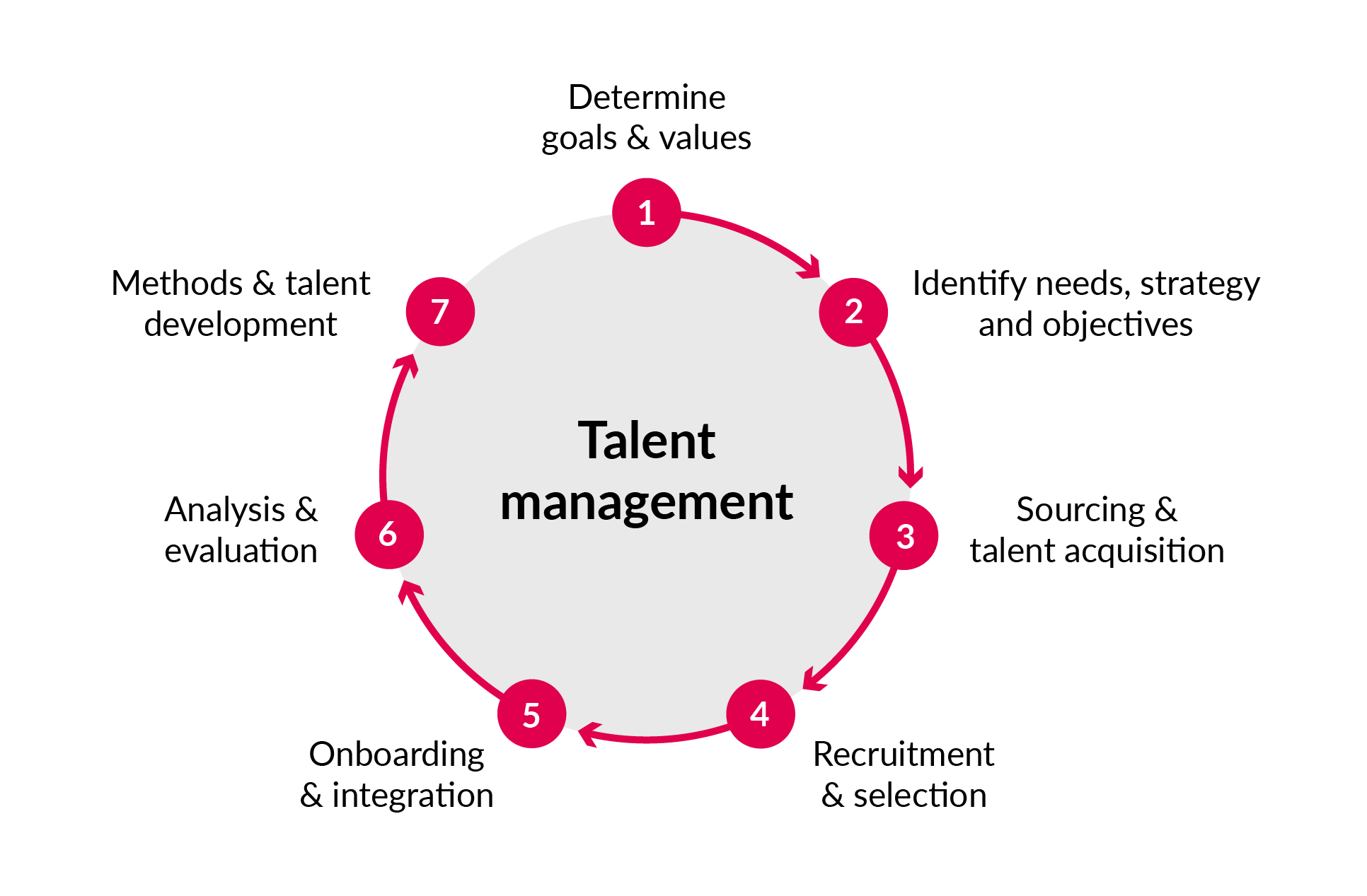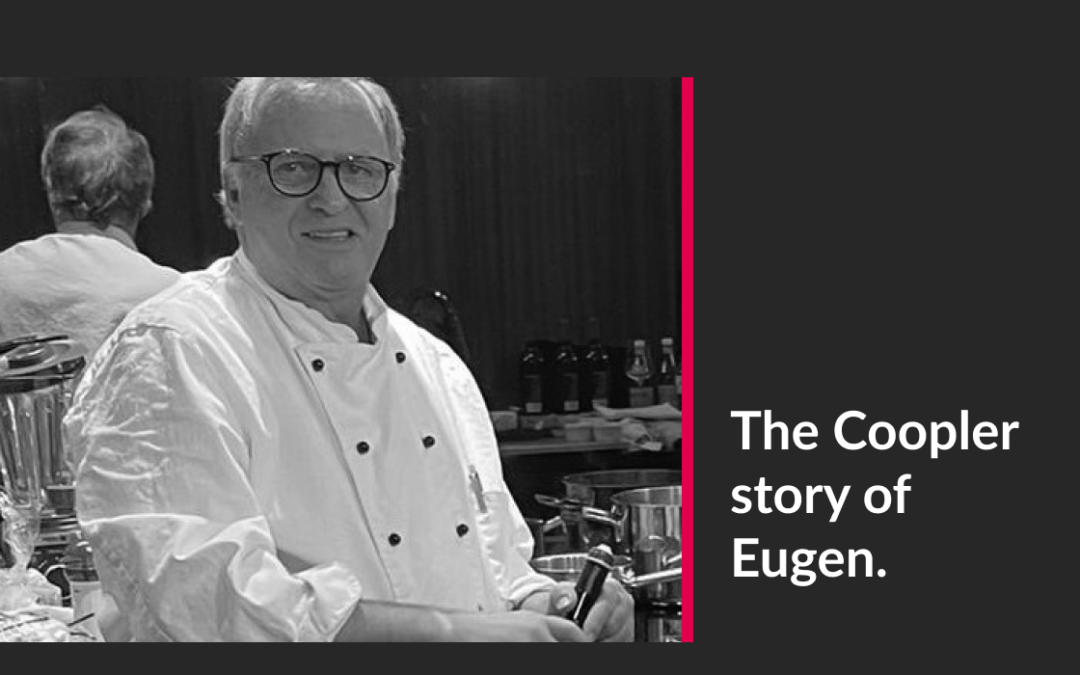
The art of talent management: How to find and retain the best employees
What is talent management: Just a buzzword, or is there more behind it?
Talent management sounds very promising, but what does it actually mean? Is it just hype or is there an actual sustainable and significant strategy behind it? According to Heyse & Ortmann (2008), talent management includes the entity of HR measures which lead to the long-term occupation of important roles and positions in the company. Talent management differs from human resource management in aiming at a rare target group which is specifically important for the company’s success. It includes the identification and promotion of skills, also known as talents.
What does ‘talent’ mean?
In the context of talent management, a talent is related to individual skills, aptitudes, and potentials of employees who can significantly contribute to the company’s success. These talents can be both inherent and acquired and they are crucial for the employees’ development, motivation, and commitment.
Other terms that can be used are “skilled“ and “unskilled“ workers. The difference between “skilled“ (with relevant qualifications) and “unskilled“ workers (without relevant qualifications) refer to individual skills which are required to successfully fulfil tasks or fill a position. Unlike “unskilled“ workers, the “skilled“ workers have the necessary expertise or professional experience in order to perform tasks successfully.

How talent management influences the company’s success
Approaching talent management strategically and systematically makes it possible to build a positive company culture and boosts its innovation. Choosing talents wisely and empowering them can create a work environment that supports cooperation and exchange. Working in a positive atmosphere supports the commitment to the company and reduces staff fluctuation. It also boosts creativity and encourages employees to share their ideas and challenge established processes. As a result, your company raises its flexibility in changing markets and gains competitive advantages. But it requires a sophisticated strategy which will be exemplified in the following section.
Talent management strategy: How to use talents in an optimal way
Talent management strategy stands for a greater plan to win the best talents for the company and to then further their professional development to maintain long-term commitment. This strategy contains the precise definition of actual goals, values, and steps to reach those goals. The strategy defines how to embed talent management in the company’s overall vision.
Defining goals and values
Talents can be used to their full extent if they pursue the company’s goals and represent the company’s values. Therefore, it is important as a company to define distinct goals and values acting as guidelines for the individual and collective work of the talents. This will boost both the efficiency and effectiveness of their contributions as well as a positive corporate culture in which the whole staff use their skills for the benefit of the company. Let’s take an innovative tech company as an example. It specialises in sustainable solutions for energy efficiency. It attaches importance to eco-friendliness, social accountability, and technological progress. Hence it is important that the talents employed by the company represent those goals and values. This process already starts during the hiring process. New employees should not only have the required qualifications but should share the company’s values and beliefs. This is important for the current staff as well. To internalize those beliefs, it is vital to constantly communicate them internally.
Configuration of talent management: Looking into the process
Talent management processes should be like a well-organized sequence of steps helping companies implement their talent strategy. These processes cover various areas, including the identification of needs, attracting talents, a smooth onboarding, boosting their skills, checking achievements, prearranging successors, and creating an attractive working environment to retain talents on a long-term basis. We will explain in detail how to implement this process step by step in the following section.
Planning: Identifying needs, strategic plans, and goals
As a first step in the talent management process, it is important to analyse carefully which specific qualifications and competencies will be required in future positions. The internal analysis of, for instance, a healthcare company, could show that it requires increased expertise and a higher number of nursing staff for its further development. So drafting and defining future requirements for talent management becomes an essential task for the company. The precise phrasing of these requirements become more and more important, especially in the healthcare business. Talent planning, or goal setting, ensure that goals and guidelines are defined for the talents.
Sourcing & talent acquisition: finding the best talents and winning them over
After the identification, planning, and goals have been clearly defined, the focus is on finding the greatest talents and trying to win them over. There are several ways of approaching talents and recruiting them. Jobs are traditionally advertised in newspapers or online job boards, which gives candidates the chance to directly apply for a position. Employment agencies act as intermediaries between companies and candidates by picking suitable applicants in a pre-selection. Social media platforms like LinkedIn enable companies to directly communicate and network with experts. Job trade fairs are a platform for direct interaction between companies and candidates. Companies can also create talent pools to identify potential candidates for future occasions.

Recruiting & selecting: the highway to a strong company
Recruiting and selecting in an effective way builds on the previous steps of the process and lays the groundwork for the successful development of the company. In the recruiting process, the focus is on identifying candidates with ideal skills and qualifications for a specific position. Recruiting should be neither too short nor too long. A hasty recruitment comes with the risk of hiring staff that is not perfectly suitable for the respective position. If the process takes too long, it could deter potential talents as they might decide to accept another position in the meantime. On top of that it affects the pace of the recruiting process if the selection process becomes too intensive. This highlights the importance of a balanced relationship between an in-depth selection process and an efficient recruiting process. It is important to get to know potential candidates better before the actual hiring.
Onboarding & integration: the key to successful onboarding
New staff members can integrate into the team and become productive fast during onboarding if there are appropriate implementation plan, in-company training, team introductions, and hands-on tasks. After all, it is important both for the new employees as well as for the company to have a successful start. To retain employees at an early stage, a suitable concept should be established with the onboarding process. Ideally, this process starts with an introduction phase. This phase starts with signing the contract and ends after the probation period. The idea of the onboarding is to introduce tasks and established processes to the new colleagues in a structured way, to present the corporate culture, and to acquaint them with the rest of the staff.
Performance rating: analysis & evaluation
After successfully completing the recruitment and onboarding and after becoming a well-integrated staff member, it is time for the performance rating phase. The precise analysis and rating of the performance is important in order to gain insight into the efficiency of processes and staff members. An in-depth performance rating allows you to take steps to accentuate strengths and identify areas for further development, with the help of either self-assessment or a personal discussion with superiors. So-called Key Performance Indicators (KPIs) help to highlight sales figures, service, knowledge, or further goals. KPIs demonstrate whether goals have been reached or which measures need to be taken in order to reach the goals.
Methods & talent development: effective basic approaches
It is essential for a sustainable corporate development to implement efficient methods and to systematically stimulate talents. Staff members get the opportunity to learn from experienced colleagues or senior managers through training courses, professional development, and mentoring programs. They gain valuable insight into their respective departments and special fields and can explore their individual development potentials. Mentoring, for instance, enables direct exchange of knowledge in which talents learn well-tried practices and get the chance to develop further in the long run. The mentor explains modes of operations to the mentee and gives advice on the mentee’s tasks. In this way, good working practices can be continued within the company in the long term.

Challenges in talent management
Even though CEOs and executives stress the importance of talent management, there are several challenges to be taken into account. Certain branches of trade, industry sectors, and regions suffer to some extent from skilled labour shortages. This complicates identifying suitable talents. On top of that, the promotion and development of talents need time and resources. However, those happen to be limited in many cases. Establishing a positive and diverse corporate culture is another challenge that often demands an extensive planning interval. It is vital to communicate corporate goals and market conditions to achieve this objective. Through communication, the employees gain the ability to flexibly implement company strategies in order to react to changing challenges. Facing theses makes considering talent management strategies even more important.
The future of talent management: How to make it work
It is important to make sure that talent management works efficiently, especially within a dynamic business environment. It is essential to optimally identify, develop, and appoint your talents, who represent the most valuable asset of your company. Talent management shows great promise in the future as it can continually adjust to the technological progress, changing market conditions, and evolving operations. The greatest influence on the preparedness of a company for forthcoming challenges and adjusting to these is the level of agility with which the company reinvents its talent management. Constant adaption to new technologies, market conditions, and operations is the key to successful talent management.



